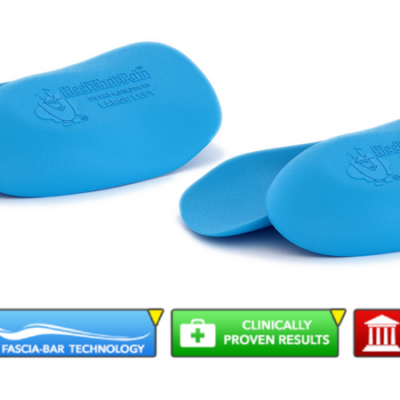All About Underpronation
When it comes to which way the foot rolls as it strikes or pushes off the ground, overpronation (where the foot rolls too far inward) usually steals the spotlight. However, while under pronation (where the foot rolls too far outward) is less common, it can cause major problems for certain people.
Let’s explore the definition of underpronation, who is at risk for underpronation, symptoms of underpronation, which injuries underpronation might cause, and the best shoes for underpronation.
What is Underpronation?
Each time your foot lands on the ground or pushes off to take a step, you pronate, or roll your ankle slightly to absorb impact or propel yourself forward. In a healthy gait, the foot rolls slightly inward. However, too much or too little pronation can cause problems.
Underpronation, or supination happens when the ankle doesn’t roll inward very far (less than 15 percent) when landing or pushing off, causing the foot to roll outward and putting pressure on the ankle and toes.
Left unmanaged, supination can lead to severe pain, injury, and damage to the tissues in the feet.
Who Is at Risk for Underpronation?
The good news is, supination/over pronation is relatively rare. However, some people have a higher risk for overpronation than others. If any of the following characteristics describe you, may underpronate:
- Individuals with high arches
- Individuals with a tight Achilles tendon (e.g., people who participate in high-impact sports that place strain and wear on the Achilles tendon)
- Individuals who have a foot or leg injury that changes the gait (e.g., hammertoes, shin splints, or knee injuries)
- People who wear unsupportive shoes
Symptoms of Underpronation
Depending on your activity level, symptoms of excessive underpronation can be subtle, for instance greater wear on the outside edges of your shoes can be a telltale sign. Most symptoms of oversupination begin to show up during high-impact sports like running, basketball, or soccer.
The most common symptoms of underpronation are pain through the arch of the foot and ball of the foot as the muscles and ligaments in the foot (especially the arch) are strained by the abnormal gait. In some cases, under pronation can also cause back pain and knee pain. Many underpronators develop calluses or bunions on the pinky toe side of the foot, since there’s too much pressure placed on this side of the foot. As a result of the feet’s abnormal mechanics, stability can become impaired, leading to more falls, rolled ankles, or sprains.
Risks of Underpronation
Underpronation can increase your risk for a number of different painful conditions:
Plantar Fasciitis
One of the biggest risks of underpronation is heel pain and plantar fasciitis. The plantar fascia ligament, which runs along the bottom of the foot and attaches to the heel bone works to distribute impact and force properly while you walk or run. However, under pronation puts excessive pressure and strain on this fibrous band of tissue, causing the band to become overstretched, worn, flattened and/or causing tears in the tissue.
Heel Spurs
Heel spurs are another risk of underpronation, developing when overuse or injury cause the plantar fascia to pull away from the heel bone. In response to this trauma, tiny calcium deposits may begin to form, which dig into sensitive tissue in the heel of the foot during movement.
Sprains, Rolled Ankles, or Other Injuries from a Fall
Because underpronation or supination creates a less stable gait, people who underpronate are at greater risk for falls and other injuries that may happen when the foot rolls too far outward and destabilizes the body during movement.
Hammertoes and Bunions
The force of push-off and landing when taking a step falls disproportionately to the outer toes (pinky toe and the outer edge of the foot), leading to bunions and hammer toes (where the toes curl under after repeated trauma and compression in the toe box.
Best Shoes for Underpronation
Wearing properly fitting shoes is one of the best ways to correct your gait and keep your foot aligned properly.
Choose supportive, comfortable shoes that have a thick sole, support your arch, fit snugly (but don’t pinch or compress your toes while you walk). Make sure you consider shoe depth and width when you choose a pair of shoes — not just the length of your foot! Each of these factors makes a difference in how well your shoes support your feet, particularly during high impact activities like running and sports.
If you supinate, opt for high-top shoes that cover the ankle, to help stabilize your gait further and avoid rolled ankles or falls. You can also add KT tape for extra ankle support! Make sure to replace your running shoes regularly! Old, worn shoes are notorious for lackluster support and poor fit.
Treating Underpronation
In addition to wearing shoes that fit correctly, you can take other steps to treat supination and reduce your risk of injury:
Warm Up and Cool Down Properly
Always properly warm up and cool down while exercising. Many athletes forget this simple, yet crucial step. But suddenly asking stiff muscles and tendons to suddenly flex and stretch after a long period of inactivity (even a few hours!) can lead to wear and tear, micro-injuries, and gait problems.
Stretch Regularly
Keeping the tissues in the plantar fascia, calves, and feet strong and flexible by stretching on a regular basis can help the muscles and ligaments in your feet and legs work together more effectively while you walk.
Stabilize Your Gait with Orthotics
An orthotic device, such as Heel Seats, can also be a valuable tool in healing overpronation and preventing cases of heel pain that may result from underpronation. Heel Seats provide structural support that may be missing from the arch (especially for people with high arches), to stabilize and normalize the gait. Orthotic inserts like Heal Seats also take pressure off heel spurs that may have formed, and cushion a thin and painful heel pad that has deteriorated from plantar fasciitis.







